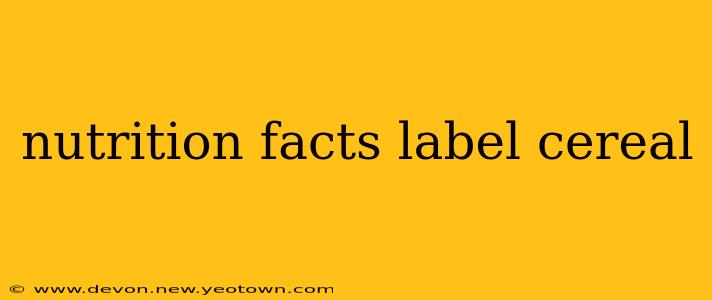We've all been there, standing in the cereal aisle, overwhelmed by colorful boxes promising everything from "all-natural" goodness to the ultimate sugary rush. But how do you actually decipher the information staring back at you from that tiny nutrition facts label? It's more than just numbers; it's a window into the nutritional content of your breakfast (or snack!). Let's unravel the mystery together.
This isn't just about calories; it's about making informed choices that fuel your body and support your health goals. Understanding the nutrition facts label empowers you to choose cereals that align with your dietary needs and preferences. Whether you're aiming for a high-fiber, low-sugar breakfast or searching for a boost of vitamins and minerals, this guide will help you navigate the label like a pro.
What Information Does a Cereal Nutrition Facts Label Provide?
The nutrition facts label is your roadmap to understanding the nutritional composition of your cereal. It’s standardized, meaning you'll find the same information presented in the same format across all packaged foods. Key components include:
- Serving Size: This is the crucial first step. Everything else on the label is based on this serving size. Pay close attention! A "serving" might be smaller than what you typically eat.
- Calories: The total energy provided per serving. This number helps you track your daily caloric intake.
- Macronutrients: This section lists the grams of fat, carbohydrates, and protein per serving. Understanding the breakdown of these macronutrients is key to balanced nutrition.
- Micronutrients: Vitamins and minerals are listed here, often as a percentage of the recommended daily value (%DV). This shows how much of each nutrient you're getting in a single serving.
- Added Sugars: This is a crucial element often overlooked. Many cereals are loaded with added sugars, which can contribute to weight gain and other health problems.
- Ingredients List: Found on the back of the box, this lists all the ingredients in descending order of weight. The ingredient listed first makes up the largest portion of the product.
How Many Calories Are in a Serving of Cereal?
The calorie count varies wildly depending on the type of cereal. A serving of a high-fiber, low-sugar cereal might contain around 100-150 calories, while a sugary, processed cereal could easily contain 200 calories or more per serving. Always check the label for the specific calorie information for your chosen cereal.
What Are the Key Nutrients to Look For in Cereal?
Ideally, you're looking for a cereal that's a good source of fiber, whole grains, and essential vitamins and minerals. Fiber aids digestion and keeps you feeling full, while whole grains provide sustained energy. Vitamins and minerals like iron and B vitamins contribute to overall health. However, it's crucial to remember that a nutrient-rich cereal can still be high in sugar—so always check the added sugar content.
How Much Sugar Should Be in a Serving of Cereal?
The American Heart Association recommends limiting added sugar to no more than 25 grams per day for women and 36 grams per day for men. Check the label to see how much added sugar is in a serving and adjust your portion size accordingly to avoid exceeding your daily limit. Many cereals contain a significant portion of your daily recommended sugar intake in just one serving.
What is the Difference Between Whole Grain and Refined Grain Cereal?
Whole grain cereals contain all parts of the grain kernel – the bran, germ, and endosperm – providing more fiber, vitamins, and minerals. Refined grain cereals, on the other hand, have had the bran and germ removed, resulting in a less nutritious product with fewer beneficial components. Look for cereals that prominently list "whole grain" as the first ingredient.
The Bottom Line: Making Informed Choices
The nutrition facts label is your best friend when navigating the cereal aisle. By taking the time to understand the information presented, you can make informed choices that support your health and wellness goals. Remember to check serving sizes, pay close attention to added sugars, and look for cereals that are good sources of whole grains, fiber, and essential nutrients. Happy cereal-choosing!

